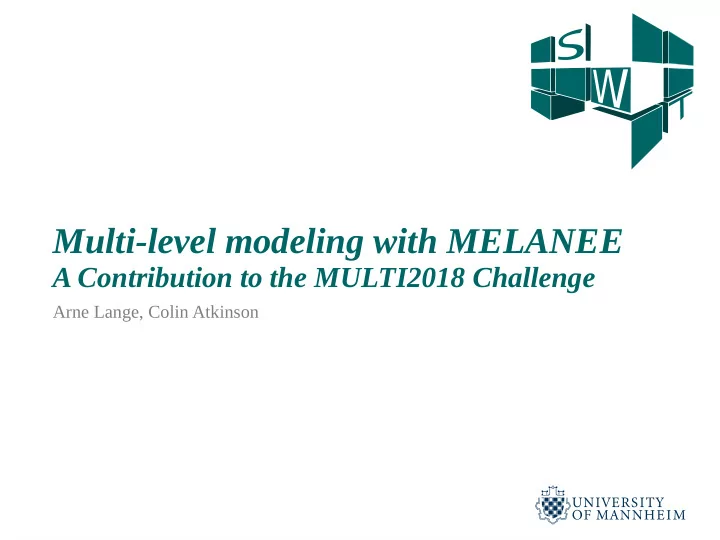

Multi-level modeling with MELANEE A Contribution to the MULTI2018 Challenge Arne Lange, Colin Atkinson
The Challenge model a bicycle shop in a multi-level fashion fulfill requirements, if necessary with the help of a constraint language solve some particular problems in the multi- level modeling domain showcase strengths and weaknesses of different multi-level modeling approaches Software Engineering Group 2
The MELANEE tool supports a deep dialect of MLM OCA (Orthogonal Classification Architecture) deep instantiation potency strict no leap potency etc. UML-like look and feel (LML) graphical Software Engineering Group 3
Level-Spanning Content Linguistic Meta-models LML (Level-Agnostic Modeling Language) deep OCL variant Enumeration Types O 0 “Material” O 1 “CyclistSize” O 2 Constraint O 3 PAN-1 Software Engineering Group 4
Isonyms vs. Hyponymns 1 Isonyms Hyponyms A A a:Integer a:Integer E:A E:A a:Integer a:Integer b:Integer 1. Bastian Kennel. A Unified Framework for Multi-level Modeling . PhD thesis, University of Mannheim, 2012. Software Engineering Group 5
PAN-Level Constraints ensuring the strictness of MELANEE only isonymic instantiation context is the DeepModel and allows for a reflective query for a specific linguistic type context DeepModel inv PAN-1: Clabject -> forAll(select(c|c.#getFeature()# -> select(f|f.#getDurability()# > 0)) -> size() = self.getDirectInstances() -> select(c|c.#getFeature()#) -> size()) Software Engineering Group 6
Product Level - O 0 basic concepts related to customers/products context Product::revenue:Real (1,2) derive O 3 : self.allInstances() -> select(c|c.#getPotency()# = 0) -> select(c|c.Invoice.date.substring(7,10) = "2017") -> collectNested(Invoice.price)->sum() Software Engineering Group 7
Bicycle Categories - O 1 product categories exploits durability and mutability of attributes invariant constraints for the lower levels context BicycleConfiguration (2,3) inv O 1 -wheelSize: self.frontWheel.size = self.rearWheel.size Software Engineering Group 8
Bicycle Configurations Level - O 2 ChallengerA2XL configuration level all invariant constraints must hold here Software Engineering Group 9
Bicycle Instances - O 3 ChallengerA2XL instance Invoice is read-only all invariant constraints must hold here Software Engineering Group 10
Example: OCL derivation Defined on level O 0 : O 1 ProfessionRacingBikeConf.:Product context Product::revenue:Real (1,2) revenue: Real = 4299.00 deriveO0 3 : self.allInstances() -> select(c|c.#getPotency()# = 0) ->select(c|c.Invoice.date. O 3 134123 0 :ChallengerA2XL substring(7,10) = "2017") -> price: Real = 4999.00 collectNested(Invoice.price) -> sum() Invoice 0 allInstances different for each price:Real= 4299.00 date:String=19.09.2017 context date is not a data type but a string SusanStorm 0 :HumanCustomer Software Engineering Group 11
Strengths of the model clabject duality and durability/mutability allow an attribute abstraction to store different data for different but related context e.g. revenue, averageRegularSalesPrice reflective and level aware/spanning constraints e.g. enforcing strictness, top seller constraint Linguistic and ontological classification allows non-ontologically typed clabjects e.g. ProfessionalRaceFrame Software Engineering Group 12
Weaknesses of the model redundant instantiation of clabjects e.g. Invoice, Customer PeterParker (as CategoryManager) clabject cannot be a Customer BicycleCategory clabject (O 1 ) is actually an abstract clabject, but has to be typed as Product → potency “2” instead of “0” Software Engineering Group 13
Hyponymic instantiation Isonym without an Hyponym with an ontological type ontological type Frame 2 :Component additional attributes height 2 :Real = 1 ProfessionalRaceFrame 2 :Component size 2 :Real = 1 usn 2 :String = 2 material 2 :MATERIAL weight 2 :Real = 1 topTubeLength 2 :Integer colour 2 :String = 2 downTubeLength 2 :Integer ProfessionalRaceFrame 2 seatTubeLength 2 :Integer height 2 :Real = 1 material 2 :MATERIAL size 2 :Real = 1 topTubeLength 2 :Integer usn 2 :String = 2 downTubeLength 2 :Integer weight 2 :Real = 1 seatTubeLength 2 :Integer colour 2 :String = 2 Software Engineering Group 14
Conclusion and Future Work completely covered all requirements in a precise and concise way did not exploit the MELANEEs DSL features in the future: Make MELANEE more flexible Allowing multiple modes of conformation (eg. strict isonymic/hyponymic) Enhance MELANEE with TREACL Transformation, Reason, Enquiry, Action, Constraint – Language Software Engineering Group 15
Thank You! Software Engineering Group 16
Recommend
More recommend